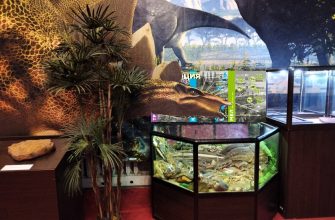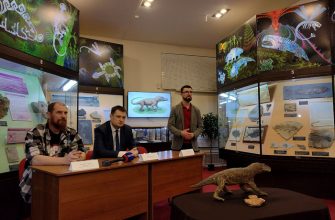The Kotelnich terrestrial fossil locality is part of the Russian Tatarian Stage of the Upper Permian. Fossil tetrapods, fish, palyno-flora, macro-flora and invertebrates have been discovered along the western bank of the Vyatka River south of Kotelnich.
As stated above there are five destinct members discernable within the Vyatka River bank outcrops to the south of Kotelnich. These are based on geomorphological differences arrising from separate depositonal events. The sequence of redbeds dips shallowly to the east but appear flat lying in outcrop because the Vyatka River has cut down through the sediments from north to south. Only to the north of Kotelnich is the easterly dip direction of the bedding evident as the Vyatka flows from northeast to southwest.
Stratigraphically detailed below is the new nomenclature for the five sequence members:
The oldest lithology is a red calcareous siltstone named the Vanyushonkov Member: formed from the deposition of floodplain and overbank silts. The main para-reptile and mammal-like reptile faunal assemblage accumulated within a localised depression into different subfacies (previously “Kotelnich-1”). Deposition ceased ans was followed by erosion leading to the formation of an unconformity. The unconformity is defined by a laterally continuous grey leached horizon. It follows the contours of the above depression.

The next lithology is an orange, fine grained sandstone named the Borovikov Member. A fine grained quartz arenite was deposited by probable aeolian processes into a wide depression (10 km). Cross-strata indicate a general palaeo-wind from the west and therefore, provenance in the west (figure 3). Compositionally and texturally mature quartz arenite (95% fine grained quartz) dominates the member. Its base is planar but not sharp in contrast to the fluvial channels higher in the stratigraphy. Because of conflicting sedimentary structures (both small scale and large scale cross-strata combined with some low lee angle dips) both fluvial and aeolian origins have been proposed for the member. A further cessation of deposition was followed by erosion, leading to the formation of a second laterally extensive unconformity.
This is followed by a laterally isolated lens of grey interbedded siltstone and medium sandstone named the Chizhev Member. A localised channel lens was eroded and infilled with interbedded sands and silts. The sediments are abundant in fossil macro-flora and palyno-floral remains. In addition, sedimentary structures include fluvial ripple laminations and abundant thin coal measures. The Chizhev Member lens has been the source of fossil remains used in Gomankov’s (1997) correlation.
Forth in the sequence is a red calcareous siltstone named the Shestakov Member. Several palaeosol horizons formed at the base of the member and resulted in the formation of a laterally extensive grey and brown, well indurated, marker horizon. Ancient rootlets are abundant within the palaeosols which are also extensively bioturbated. Vertebrate fossils are rare except for a localised depression at the northern most part of the section (immediately south of the Kotelnich River Port – dicynodont site).
Dicynodont site: localised variation of lithology includes grey sand grading up to the ambient flood-plain silts of the Shestakov Member. Deposition of mass death assemblage of a single tetrapod group (dicynodont). Over 70 individuals have so far been discovered within a lateral extent of 400 metres and a stratigraphic thickness of less than 2 metres.
At the top of the sequence lies a green, cobble conglomerate grading to a course to medium sandstone. This lithology is localised in five destinct ancient fluvial channel lenses that eventually grade into a red calcareous claystone-siltstone. The uppermost sequence is interbedded with beige, marl rich beds giving the highest cliffs of the Vyatka River’s western bank a striped appearance. The combined green channel lenses and red fine grained overbank deposits are named the Sokolovogora Member since they constitute a near continuous depositional event. The resumption of deposition resulted in a cobble to pebble sized conglomerate at the base of the channels. Most of the channel fill is a medium sandstone derived from a metamorphic basement provenance, probably washed from the western slopes of the newly uplifted Urals. Fossil remains include tree stumps and disarticulated bones of mammal-like reptiles (previously “Kotelnich-2”). Once the channels filled with sediment, lower energy conditions prevailed with the resumption of siltstone flood plain deposits. The red sediments contain a rich fossil invertebrate fauna of fresh water ostracods and bivalves. However, vertebrate remains are absent from the upper deposits perhaps indicating a change in palaeo-environment to lacastrine conditions.






